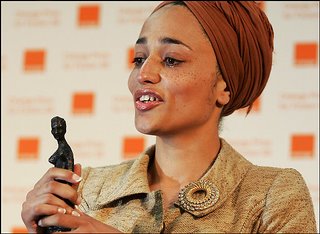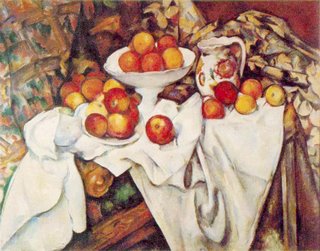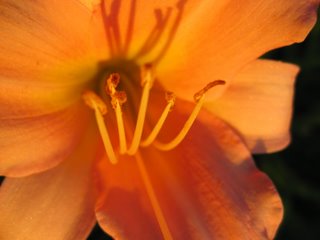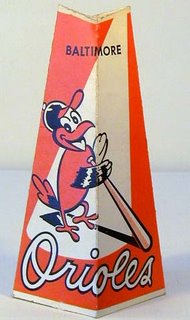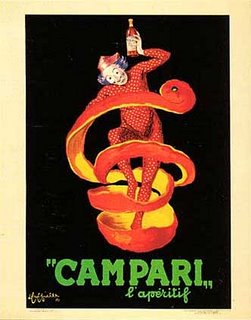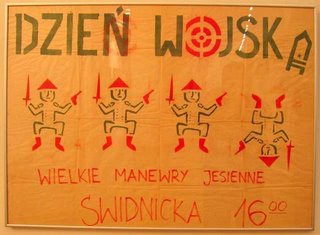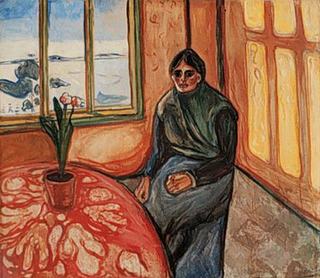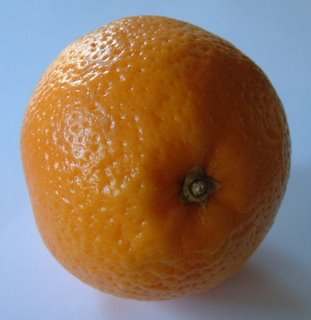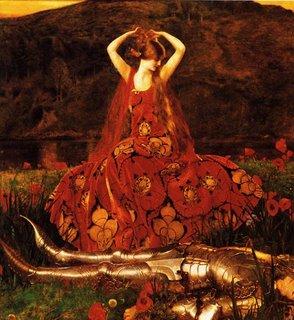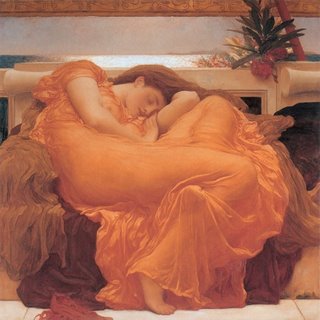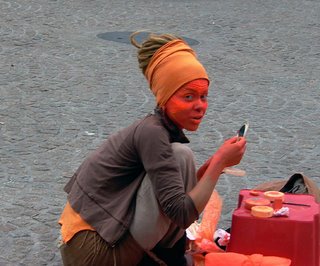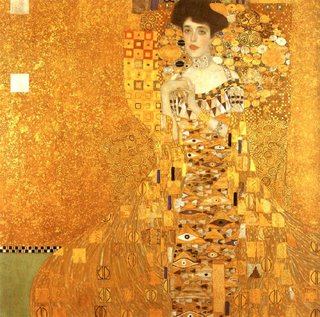
Frank Sinatra and Duke Ellington, Yellow Days.
Frank Sinatra, The Moon Was Yellow.
Zhang Ruei, Song of the Yellow River
Oregon, Yellow Bell.
Syd Barrett, Golden Hair.
Screamin' Jay Hawkins, Yellow Coat.
The Ventures, Yellow Jacket.
Yo La Tengo, Yellow Sarong.
Peggy Lee, Golden Earrings.
Cab Calloway, Yaller.
Leadbelly, Yellow Gal.
Gene Autry, The Yellow Rose of Texas.
Arthur Collins and Byron G. Harlan, When That Little Yellow Fellow Plays Piano (Hannah Plays Banjo).
Randy Newman, Yellow Man.
Harry Raderman's Jazz Orchestra, Yellow Dog Blues.
Bessie Smith, Yellow Dog Blues.
The Beatles, Mean Mr. Mustard (demo).
The Idle Race, Here We Go Round the Lemon Tree.
20/20, Yellow Pills.
Brian Eno, Golden Hours.
And she walks firmly through the color yellow
to cry, because I seem to her to be
getting old, on the blade of my sword,
in the delta of my face.
César Vallejo, El Buen Sentido (The Right Meaning).
Yellow is the most contradictory of colors, signifying both sacredness (the nimbi of angels and saints, crowns, wedding rings) and bodily rot; it marks both the fruit of harvest and the sere touch of winter. But, when pressed, the dark side of yellow tends to win out. It is few people's favorite color--many find there is something disturbing about it. "The yellow stripe/of thin but valid treacheries," as Edna St. Vincent Millay wrote in The Plaid Dress.
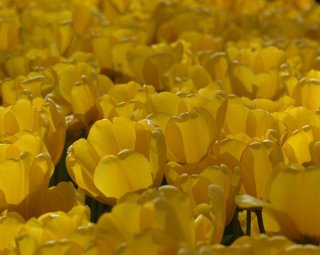
It is the color of betrayal and cowardice, of sorrow, hunger (starving people's flesh often yellows) and death, of some of the body's viler aspects and afflictions: it is the hue of bile, adipose tissue, plantar warts, eye crusts, pus ("Yellow matter custard/dripping from a dead dog's eye", as John Lennon sang in "I Am the Walrus"), weak bruises, plaque on teeth, and urine. Indeed, Indian yellow, the coveted yellow pigment that was favored by 19th Century artists, was said to be made out of snake urine, or camel urine, or, my favorite, from the piss of cows that were fed mango leaves. (From Victoria Finlay's Color, in which Finlay travels to Bihar to find the source of the yellow.)

Indian yellow pigment nuggets--wash hands after using
The color is repellent, almost revolting; a smouldering unclean yellow, strangely faded by the slow-turning sunlight.
It is a dull yet lurid orange in some places, a sickly sulphur tint in others.
No wonder the children hated it! I should hate it myself if I had to live in this room long.
So writes the narrator of Charlotte Perkins Gilman's The Yellow Wallpaper, describing her room of confinement. Later in the story she adds, "It is the strangest yellow, that wall-paper! It makes me think of all the yellow things I ever saw--not beautiful ones like buttercups, but old foul, bad yellow things."
While red and orange are also the colors of warnings, doom and danger, yellow has specifically unnerving connotations--a yellow flag flying indicates quarantine, having a "yellow sheet" indicates a criminal record, life-vests on airplanes are generally yellow, and yellow is the most common color of fallout shelter signs and haz-mat suits.

And a whole age of lingering moments crept
Sluggishly by, ere more contentment swept
Away at once the deadly yellow spleen.
Keats, Endymion.
But for all its sins, yellow goes well with music. Both Scriabin and Rimsky-Korsakov heard yellow and gold in the key of D major (fittingly, the key of "Mellow Yellow"), considered the "key of glory" by many composers of the Baroque period, and used in dozens upon dozens of violin and horn concertos throughout the centuries.
Many people hear in unison brass or winds a solid, resounding gold color. Whitney Balliett wrote of Duke Ellington's clarinets having a chrome yellow tone, Alex Ross of the "dark-gold sound" of the Berlin Philharmonic. (And do the uniform yellow spines of Deutsche Grammophon classical LPs and CDs create the illusion of a golden sound in the performances of von Karajan, Anne-Sophie Mutter and others?)
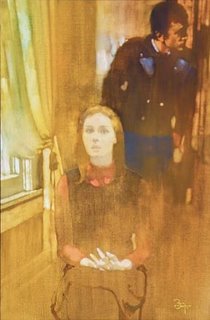
Bernie Fuchs, Pensive Moment, 1981
Happy memories seem golden, as reported in the Frank Sinatra-Duke Ellington duet "Yellow Days." "Yellow Days" is a strange bird--the song, written by Alvaro Camarillo, was originally known as "La Mentira" ("The Lie") whose original lyrics were a fevered paean to jealousy and betrayal, and whose final lines are: "You feel no pain to leave me/And this covenant is not with God!". However, by the time Duke and Sinatra performed it in 1968, "La Mentira" had been renamed "Yellow Days" and acquired a new set of lyrics, by Alan Bernstein, in which all the lust and despair has been transmuted into golden nostalgia. On 1968's Francis A and Edward K, one of the last good Sinatra (and Ellington) records. Sinatra reportedly wore a yellow-green paisley necktie to the sessions, for which I blame Mia Farrow.
Turn me to my yellow leaves,
I am better satisfied;
There is something in me grieves—
That was never born, and died.
William Stanley Braithwaite.

Matisse, Deux fillettes, fond jaune et rouge, 1947.
And follow it up with a recording from Sinatra's own yellow days, the florid "The Moon Was Yellow", from 1945. Sinatra would record "Moon is Yellow" again in the '50s and '60s, but this, his earliest take, is a bit hard to find on CD these days--it's buried deep in the wildly expensive Complete Columbia Years and that's about it. You might want to seek out some LPs of the Columbia period, such as the 2-LP set In the Beginning, which is my source for it.
Keen lemon-yellow hurts the eye as much as a prolonged and shrill bugle note note the ear.
Vassily Kandinsky, Concerning the Spiritual in Art.
The sacred yellow

One great exception to the cultural distaste for yellow is in China, where yellow has always been the color of royalty, dating back to 2600 BC, the days of the Yellow Emperor Huang Di (who is buried in the Yellow Tomb). Emperors were carried on yellow sedan chairs, actors in Chinese opera painted their faces yellow to indicate piety, Confucian ceremonies are often performed by people wearing yellow. For China's neighbors, the color became China's trademark--the Japanese courtesan/genius Sei Shonagon wrote of "Chinese-yellow coats" in her Pillow Book.
The Yellow River gets its name from the fertile yellow mud along its shores. "Song of the Yellow River" is performed by the composer Zhang Ruei on the erhu, a traditional Chinese instrument. If you live in or visit NYC and ever take the N/R/W train, a guy often plays erhu on the 57th St. platform. On Moon Reflected in Er-Quan, from last year.
And the meditative "Yellow Bell" is by the jazz group Oregon, which attempted to fuse Western and Eastern musics--with sitar, tabla, oboe and guitar in lengthy conversation with each other. On the out-of-print Out of the Woods, from 1978.

Gauguin, Yellow Christ, 1889.
At the gateway
Of evening, of lion-blond autumn, leonine death-gold of autumn
Adorning, the answer does come, in splendor of lutesong
Arising within me:
the soul is alone
--like the flowers of
Yellowwoods…
Allen Grossman, Sentinel Yellowwoods.
Blonde on Blonde

Of course, blonde hair is perhaps yellow's finest accomplishment, at least the one popular culture seems to welcome the most. Preference for blond hair even dates back to the classical era, and by the Middle Ages women were dying their hair yellow, even in areas like Scandinavia, where blondes were common. (Blonde on Blonde was rumored to be Dylan's reference to Edie Sedgwick, who dyed her natural dirty-blonde hair a platinum sheen.) Why blondes? (don't ask me--I'm a brunette fan.) Some think it dates back to the belief that blondes had been touched by the sun, with the sun's gold having a blessed quality to it. (“the gold of heavenly sunlight represents the only positive manifestation of yellow”--Herman Pleij.)

And you could spend years recounting the number of notable blondes, from Sam Spade (described by Dashiell Hammett as looking like "a blond Satan") to Thor to Rita Hayworth's shocking blonde bob in Lady from Shanghai.
The late Syd Barrett's "Golden Hair" is off 1970's The Madcap Laughs.
Wearing yellow
In the West, yellow has typically been the color of heathens and outsiders--in the Middle Ages, Jews and Muslims had to wear yellow. For example, the Fourth Lateran Council of 1215 mandated that Jews had to be "marked off in the eyes of the public from other peoples through the character of their dress." This meant they had to wear yellow identification badges, or pointed yellow hats--800 years later, the Nazis forced Jews to wear yellow cloth armbands. And during the Spanish Inquisition, heretics were forced to wear the sanbenito: "victims were robed in yellow, to denote heresy and treason." (Alexander Theroux, whose essay once again has served as a huge source of information.)

It was considered a great insult to wear yellow in the presence of an equal or superior, and those that did were essentially throwing down the gauntlet – for example Hendrik van Wurrtemberg ordered his entire retinue to dress in yellow livery as they marched past the Duke of Burgundy, Charles the Bold, in 1474. As late as the eighteenth century people would wear yellow hose or yellow shoes as signs of jealousy.
We ignore the coming doom of gold
and we are glad in this bright metal season.
Even the dead laugh among the goldenrod.
Sylvia Plath, Gold Mouths Cry.
Don the yellow wardrobe:

What walks on two feet
and looks like a goat?
That crazy Screamin' Jay
in a bright yellow coat!
"Yellow Coat", a great bit of rock & roll surrealism from Screamin' Jay Hawkins, is from 1957. Screamin' Jay's coat, made out of goatskin and...ugh, is it foreskin? Or frogskin? The get-up is outlandish that even a tribe of mountain goats gather around to stare at him. On Voodoo Jive.

"Yellow Jacket" was a single released in 1962 by the Ventures, and also included on one of the inspirations for this series, their LP The Colorful Ventures. This version, however, is from Live in Japan '65, possibly the best recording the band ever made. It's loud, fast, and the Ventures stomp through it all the way--they get through some 29 songs in little more than a half-hour.

"Yellow Sarong" was originally recorded by the 1980s NYC-based The Scene is Now. This cover by Yo La Tengo is from 1990's Fakebook, one of my favorite records of theirs.
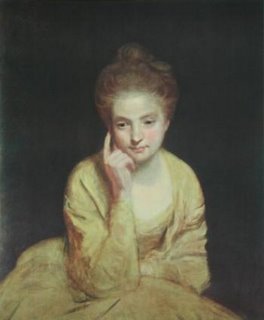
Yellow can be the color of celebration. Hindus, for example, wear yellow to welcome the arrival of spring on Vasant Panchami. And it is the color of less noble types of rejoicing--in 1536, Henry VIII, Anne Boleyn and their court (including the young Princess Elizabeth) wore yellow to celebrate the death of Henry's first wife, the long-suffering Catherine of Aragon, who had been hindering Henry and Anne from getting married. (Anne, having failed to provide a male heir and increasingly getting on Henry's nerves, would head to the chopping block the same year to make room for Henry's third wife, the fecund but equally doomed Jane Seymour.)
"Golden Earrings", Peggy Lee's gypsy fantasy from 1947, is on The Early Years.
Yellow Roses
Ain't even bad, I ain't even good,
I don't understand and I ain't understood,
Not a friend sticks to the end when you're yaller.
Yellow, in the United States, has had a long, weary racial history. In the 19th Century, it became common to refer to people of mixed race ancestry, such as Creoles, as "yellow". By the early 20th Century, the phrase "high yellers" had come into vogue--often referring to light-skinned black women ("Are they all banana-colored at Grande Anse? and all as pretty as these?" asks Lafcadio Hearn of the local women in Two Years in the French West Indies.) And a special, wounding type of prejudice against lighter-skinned blacks continues to this day.
In song, lighter-skinned blacks were either referred to with longing and envy ("I'm steppin' out with them high yellows/Snubbin' all the other fellows" goes a line in "Honey Hush") or as tragic figures, trapped between the black and white worlds. The poignant "Yaller" describes the latter. Libby Holman first sang it in Three’s A Crowd, in 1930. Cab Calloway's take, from the same year, can be found on The Early Years.
"Yellow Gal," from 1940, is by Leadbelly with backup by the Golden Gate Jubilee Quartet. On Take This Hammer.
"Yellow Rose of Texas" was originally about an African-American woman, possibly Emily West, a free-born black woman. Some of the first lyrics went as follows:
There’s a yellow rose in Texas
That I'm a goin' to see
No other darky knows her
No one only me
She’s the sweetest rose of color
This darky ever knew
Her eyes are bright as diamonds
They sparkle like the dew
But after the Civil War, when the song became a popular standard, the references to race not-so-mysteriously vanished. Gene Autry's classic version, from 1933, is on Essential Gene Autry.
And then we have a slice of pure mistrelsy, "When That Little Yella Fella Plays Piano," as performed by Collins and Harlan in 1916.

Yellow has also been an identifying slur used against Asians for more than a century (more on the "Yellow Terror" or "Yellow Peril" here). Randy Newman's "Yellow Man", from 1970's 12 Songs, is one of his first racism satires--sequenced, on the LP, between a straight-faced cover of the 1920s "uptown darkies" song "Underneath the Harlem Moon", and "My Old Kentucky Home", an ode to inbred rednecks. "Yellow Man" is, as Newman said on his Live LP, a pin-head's fantasy about the life of Asians.
Gone to the Yellow Dog
'Yellow dog' is one of those marvelous American phrases--a "yellow dog" Democrat is an utterly loyal Democrat who would vote for a yellow dog rather than a Republican; a 'yellow dog' contract forbids an employee from joining a union. 'Yellow Dog' was also the name of a notorious bootleg CD manufacturer of the 1990s.
"Yellow Dog Blues," written by WC Handy in 1914, refers to the Southern Railway's intersection with the Yazoo Delta Railroad, known locally as the "Yellow Dog." (The legend is that a railroad worker, seeing the Y.D. initials on a Yazoo Delta train, said they stood for "Yella Dog.") So "Your easy rider's gone where the Southern cross the Yellow Dog" means, essentially, that your man has skipped out on you by catching a train going out of town.
It soon became a jazz staple--Harry Raderman's Jazz Orchestra worked on "Yellow Dog" in 1921, and Bessie Smith's fantastic version is from 1925, and features Fletcher Henderson on piano and Coleman Hawkins on tenor sax. On Complete Recordings Vol. 2.
The sallow and the surreal
What about yellow is so unnerving? Yellow eyes generally denote something mysterious and alien. The medieval Flemish poet Jacob van Maerlant wrote, in his 'natural history', of a “cruel people east of India" who have yellow eyes. So does Rosemary's baby ("he has his father's eyes!"). Ray Bradbury's Martians have "yellow coin eyes" ("every morning you could see Mrs. K eating the golden fruits that grew from the crystal walls.")
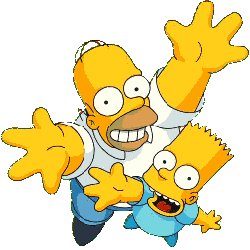
Yellow faces are also generally sources of fear, from Mrs. Danvers in Daphne Du Maurier's Rebecca, who has patches of yellow beneath her ears, to some of Sherlock Holmes' more ghastly enemies, like Dr. Roylott in "The Adventure of the Speckled Band" who has a "face burned yellow with the sun and marked by every evil passion."
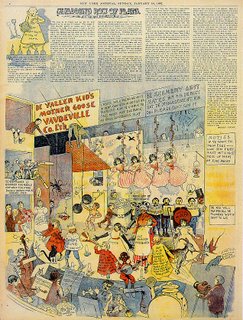
The Yellow Kid
Perhaps yellow simply signifies the unknown. Marlow, the narrator of Joseph Conrad's Heart of Darkness, on his way deep into the Belgian Congo to find Kurtz, views a Congo map "marked with all the colors of the rainbow":
There was a vast amount of red--good to see at any time, because one knows that some real work is done in there, a deuce of a lot of blue, a little green, smears of orange...However, I wasn't going into any of these. I was going into the yellow. Dead in the centre. And the river was there-- fascinating--deadly--like a snake. Ough!
"Mean Mr. Mustard" was a song fragment John Lennon wrote in India, in 1968--he never really came up with a chorus (you can verify that by listening to this demo, recorded in the weeks before the Beatles began the White Album sessions), and shelved the song until the Beatles were looking for scraps to be sewn together in the "Long Melody" on Abbey Road the following year. On Anthology 3.
Yellow, like orange, has its psychedelic side. If only all psychedelic songs were as fun as "Here We Go Round the Lemon Tree", in which the singer spies on his next door neighbor, a girl in a silver bikini who dances, chanting, around a lemon tree in her back yard. He throws stones at her to calm her down, and when that doesn't work, he puts on a pair of green underpants and joins her dance. The song was originally recorded by the Move; this is a 1967 cover by the Idle Race, Jeff Lynne's first band. It's a rarity--the only place you can find it is on the expensive, out of print and possibly bootleg Back to the Story.
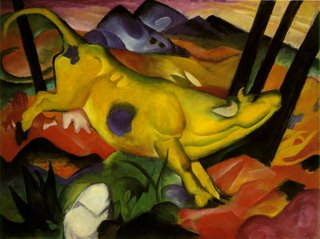
Franz Marc, Yellow Cow, 1911.
It's also a common pharmaceutical color. Nembutal, which Marilyn Monroe used in her overdose, has a slang name of "yellow jackets," and 5 mg Valium (the most common dose) is yellow as well ("and though she's not really ill/there's a little yellow pill", sang Mick Jagger of the pill-popping housewife in "Mother's Little Helper"); "yellow sunshine" is a common name for acid. 20/20's "Yellow Pills" is from 1979. Find it on tons of 'power pop' compilations, like this one.
Enough--sit down and watch the golden hours pass. From Brian Eno's Another Green World.
Yeah, I know--no "Mellow Yellow". No "Yellow Submarine", or that Coldplay song. Did you really need to hear them again?
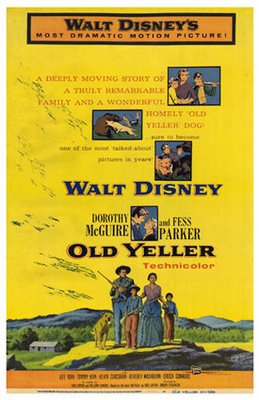
Cover star: Klimt's Adele Bloch-Bauer.
Next:
My salad days,
When I was green in judgment: cold in blood,
To say as I said then!
